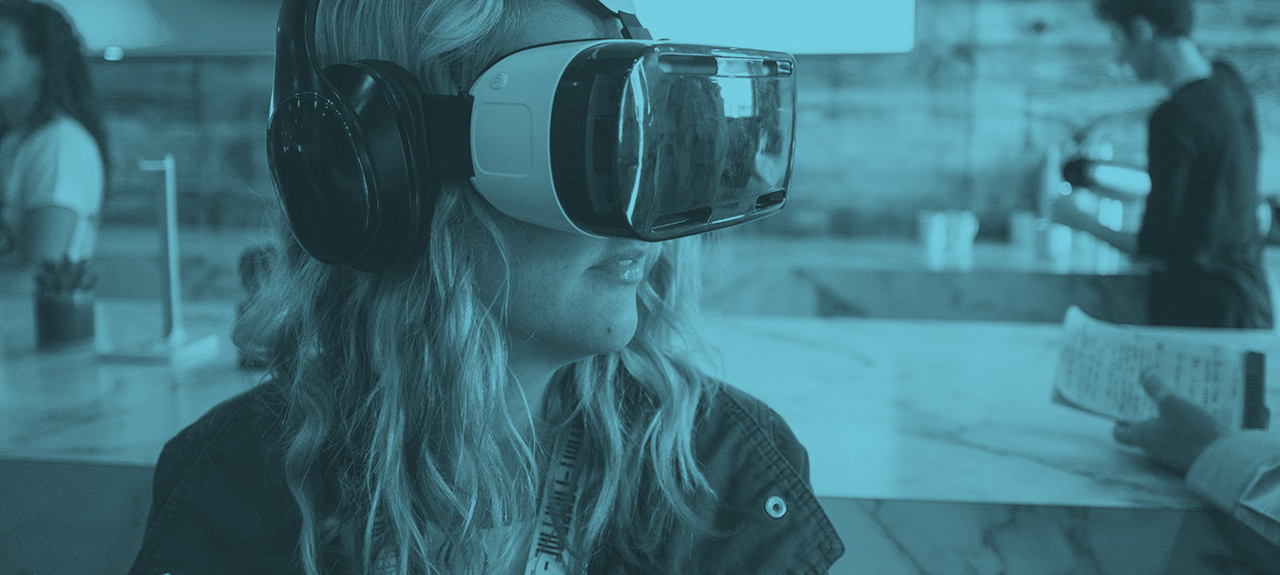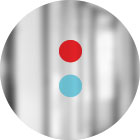So, why was VR everywhere?
The short answer: to either show off technology or get people in the door to SXSWi (South by Southwest Interactive).
Samsung, for example, had a VR roller coaster experience that was incredible, complete with moving seats. It was the closest thing to riding a roller coaster, other than actually riding a roller coaster. And this still may have been cooler. The only thing missing was wind blowing in your hair. While Samsung was certainly showing off their technology, they were really focused on demonstrating the power of the platform. As brands have found out over the years, a platform is only as good and relevant as its content, and Samsung is yearning for more and more content to fill their Samsung Gear and Milk VR platforms. If a virtual roller coaster ride that feels like the real deal doesn’t get content creators excited about the possibilities, nothing will.

IBM was in a similar boat. They wanted to show off the technologies they provide that make VR possible. That make it better. That will help it reach its true potential. And that’s what they wanted to show off in their Cognitive Studio space, using a headset and a bike to make riding a stationary bike suck a whole lot less. And truthfully, we walked away thinking, “I could do that for an hour.”
But what about McDonald’s? You can’t virtually eat a burger, so why on earth would they have VR? Simply put, they wanted to get people in the door. VR isn’t something that is readily available at this exact point in time. For lots of people the only time you get to give the technology a test drive is at events like this, and McDonald’s was clearly tapping into that market. By offering VR they were able to entice people into their experience, and once there it only became natural to check out what else they had going on. Their Vive game was incredibly simple: you could paint all around you using paint brushes and paint guns. It had nothing to do with flipping burgers or serving customers, but it was incredibly fun and left you with a big smile on your face. And when it comes down to it, isn’t that what McDonald’s is all about? Making people happy and “Lovin’ it”? On a side note, the customized burgers they were serving were easily the best McDonald’s burgers we’d ever had, and we wouldn’t have discovered that if it hadn’t been for the VR experience sucking us in.

Why does a technology conference lack technology?
Upon arrival at SXSW you have to wait in line to go through registration, and while we were smart enough to get in on Thursday and skip the lines, most people were forced to wait over an hour Friday morning to get registered. Which is insane, because this is an interactive conference focused on technology, yet there was no sort of mobile or online check-in that sped up the process. Checked in through the app? You STILL had to wait in line to get your badge. Even the airports have figured out how to let you check-in through your phone, have a boarding pass on your phone, and skip as many lines and pieces of paper as possible. But not SXSW. You had to wait in line to get a paper badge that you wear around your neck to get into anything. There was no phone app or other technology that granted you access (other than an RFID chip on your badge, which isn’t exactly an emerging technology). So why is that? Status. Wearing the badge around your neck is a status symbol. It shows that you have access. That you belong. That you’re supposed to be here. That you are a part of this big, amazing experience that takes over a city for 3 weeks. And because of that I don’t think badges will ever go away, no matter how far technology advances.
Do you have to use technology to stand out at a conference celebrating technology?
No, no you don’t. The fact of the matter is two of our favorite experiences were anti-technology. The American Greetings #analog experience allowed you to have artists create letters for loved ones that you could mail on the spot, listen to vinyl records, help color a wall, and create a tangible gif that you had to assemble with your own two hands but could still share on your social channels. It was very satisfying and a nice break from “the next big thing” that everyone else was touting.
And Google had an hour-long wait to try your hand at the classic claw game you find in every arcade and pizza joint. You know, the one that your kids spend $20 on in order to win a plush toy worth $1? People waited an hour to do it at Google. And while the prizes included phones and smart watches, people were waiting for the joy and simplicity of moving that arm for a chance to win. The prizes were simply icing on the cake (for the few people who actually won).

How many steps did you take each day?
SXSW requires a lot of walking. From panel to panel, speaker to speaker, experience to experience, and bar to bar, walking is just easier and more efficient than getting in a car. The Switch average was 21,137 steps each day.
What does SXSWi have in common with the local Austin music scene?
We were lucky enough to partake in some local music at night while we were in Austin, and there are three similarities that stuck out to us.
- A little something for everyone. No matter what kind of music you like, you could find it in Austin. SXSWi was no different. Whatever your interests were, you could find a speaker, panel, session, experience or special event that was relevant to you. Especially if your interests revolved around VR.
- Standing out amongst the crowd. In the Music Capital of the World, differentiating yourself from every other band is important, which is no different for all the various sessions that happen throughout the week. Every session needs to be unique, delivering a distinct perspective from everyone else. And while bands use their name to try and get people’s attention, speakers use the title of their session to accomplish the same goal (which often leads to misleading attendees, but that’s another story for another time).
- The power of storytelling. Every song has a story. The story that went into creating it, and the story that lives within the lyrics. And storytelling is a big part of what happens throughout SXSW. From every experience a brand puts on to the speakers leading every session or panel, if you aren’t telling a story worth telling then people aren’t going to be listening.
Yes, SXSW is an excuse to get out of town, visit a great city, eat lots and lots and lots of tacos and indulge in some incredible BBQ. But it’s also a great place to learn, and we look forward to going back to school again next year.














